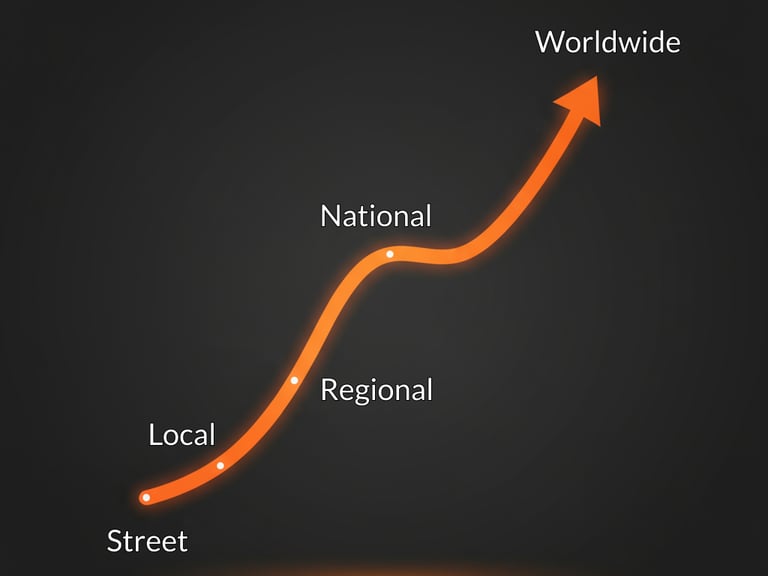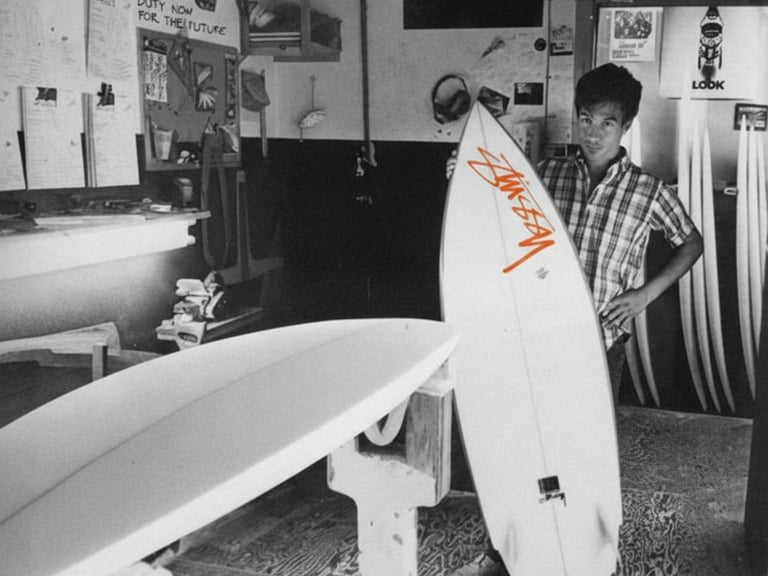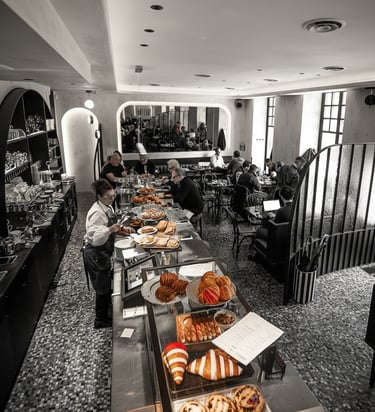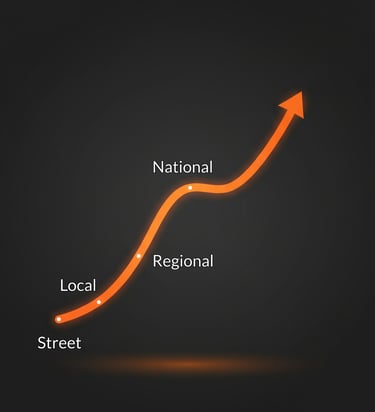The Recognition Arc Model
At Nourish Production, we know that you want to be recognized as a brand that people trust. Therefore, we present you our model that help you scale your brand's level of recognition
BRAND STRATEGYRESEARCHBRAND RECOGNITIONTHE RECOGNITION ARC
Nour Fahed
11/13/202510 min read
Brand recognition is the feeling you get as a person when you hear an artist’s song or see a brand’s logo. Our subconscious often picks up on these cues.
At Nourish Production, we know that you want to be recognized as a brand that people trust. To achieve this, you need recognition, transitioning from local obscurity to widespread awareness, ideally culminating in a national or global reputation. The problem is that your brand isn’t getting noticed, despite offering good products or services, which can make you feel defeated.
We believe that good work deserves to be seen. Every brand that adds value to people’s lives deserves recognition. We understand that it is hard to build something great, but it feels like no one sees it, which is why we provide you with a Recognition Arc model based on proven branding and customer behavioural theories.
Brand Recognition VS. Awareness
Recognition is the antidote to awareness because awareness can be misleading. We notice thousands of things every day, but what stays with us are the things we truly recognize.
Brand recognition refers to the ability to identify a brand by its visual appearance or auditory characteristics, whereas brand awareness is simply knowing that a brand exists and what it represents. Awareness alone only gives us small pieces of what a brand offers. Recognition, on the other hand, tells the whole story, while awareness can feel incomplete and unclear.
Nike is a brand that almost everyone recognizes. Their slogan, “Just do it,” instantly connects with us. We all know Nike sells shoes, but being aware of that is not enough. Nike is recognized for much more than just selling sports shoes, and this recognition often happens through intuition.
When your brand is recognized, it means people can identify it almost instinctively. This makes it easier for customers to decide to buy and helps them connect your brand’s colors, logo, or shape with unique experiences, even if those details are only noticed faintly.
A study on how people make decisions looked at brain scans of people shown pairs of brand photos. The results showed that when someone’s favorite brand was present, their brain reacted differently than when only unfamiliar brands were shown. With a favorite brand, people made choices instantly and used less reflective thinking. This shows that when your brand helps customers buy easily, it has achieved recognition. Customers understand its value right away, without needing to think it over. They just do it!
The Recognition Arch
Nour Fahed and Marius Wenneson developed the recognition arch model. This idea suggests that a brand’s journey is not a straight line. Instead, it follows an arch that begins at the street level and rises to the global stage.


Brand recognition isn’t instant. It’s built one stage at a time. When you understand each stage, you can control how far your brand will reach. At Nourish Production We call this journey the Recognition arc. Therefore, we see brand recognition as a arch that starts with being known in your local area, which we call street level. At this stage, bold visuals help you stand out and get noticed.
The next step is the local level, where social, cultural, and economic factors help your brand get noticed in your community.
After that, your brand can gain regional recognition as it spreads beyond your town to nearby areas.
You reach national recognition when your message connects with people from different backgrounds all over the country.
The final stage, which we call going from street to global riches, is when your brand reaches millions of people around the world and leaves a lasting mark.
This means that on the steps of this model we have distinguished elements that play role with deciding each stage of the recognition arch. These elements can be called as capitals as social and economic capitals decided by the annual income and brand reputation. It’s worth to mention that brand recognition is relative depending on the level of the brand on the recognition arch in which a brand can be recognized by a on the street level but unknown on the local, regional, national or global level. And the same thing applies on all level.
Method of Brand Recognition Development
At Nourish Production we use the Symbiotic Model of Influence to develop the brands we work with in order to take them to the next level of Recognition Arc. You can read more about the Symbiotic Model of Influence.
Street Level


Street recognition isn’t just about being seen; it’s about the vibe you create. To stand out on your street, you need to match your brand’s spirit with the energy of your surroundings.
In Indonesia, a study of 40 local brands revealed something every small business can use:The colors and symbols you pick don’t just decorate your brand; they influence how people decide to buy.
Here’s what they found:
Warm colors in street food logos encourage impulse buying and attention.
Muted, earthy tones in coffee shop logos create a sense of trust and foster long-term engagement, conveying premium quality and artisanal values.
Visual branding clearly affects how people see your brand and what they decide to buy.
Southern California, 1980s. Surfboards, salt air, and streetwear before streetwear existed. Shawn Stussy wasn’t following trends. He shaped surfboards and signed his name on each one. That signature, a raw handwritten mark, became his brand. He didn’t launch in a store. He sold t-shirts and hats from his car to the same people who surfed the same waves he loved. That’s how street recognition begins: when your business and your environment move in sync. Stussy matched his visual branding to what his target market wanted, in this case, the beach vibe.
At the street level, the right visuals can help your brand stand out and draw in customers.
So, if your visuals match your brand’s spirit, you’ve earned your street cred. That’s your first step on the recognition ladder. But visibility is just the start. The next level is moving from being seen to being trusted, as your street becomes your community.


Local Level


Let’s say you have a corner of recognition in every heart on your street. Now, let’s take your brand one step higher by connecting it with your community’s heartbeat.
Getting local recognition takes more than just selling. It’s about belonging and becoming part of everyday life in your town.
A research paper found that people connect most with brands that reflect their cultural values, offer quality and fairness, and evoke a sense of familiarity, like being at home. That’s the science behind why we feel we belong. It’s also the foundation of local recognition. When your brand reflects local values, traditions, and pride, it becomes more than a business. It starts a conversation, just like Café Saturnus did.
In 1989, on a cold winter day, people gathered there to share warmth, art, and ideas. The smell of roasted beans blended with laughter and curiosity. It wasn’t just a café. It became a cultural landmark. Café Saturnus didn’t just serve coffee. It gave people a sense of identity. It showed that when a brand understands its environment, including the people, tone, and symbols, it doesn’t just gain customers. It earns the trust of the community.
If you’re building your brand, ask yourself this:
Does your business speak your city’s language?
Does it look, sound, and feel like the people it serves?
That’s where local recognition begins with a shared story between you and your community. So if your brand feels ready to grow beyond your borders, how do you take that trust and spread it across your region?


Regional Level


So far, you’ve earned recognition in your local community. That’s a great start! Now it’s time to let your influence grow. Make your brand a symbol that connects towns, cities, and people.
Regional recognition happens when your brand’s voice reaches beyond your town and becomes part of a shared identity. Research supports this. Regional branding doesn’t just raise visibility. It builds credibility, creates shared pride, and boosts the reputation of every brand involved.
A perfect example of this comes from the vineyards of Bordeaux. For years, each village and château had its own label and proud heritage. On their own, though, their voices were scattered. Then a simple, powerful idea appeared: “Côtes de Bordeaux.” It became an umbrella identity that united them all. This regional brand didn’t erase individuality. It made it stronger.
Each producer kept their own name, story, and flavour. Together, they became stronger, more recognizable, and more trusted around the world.
That’s the power of regional recognition. You move from standing out alone to standing together with a shared purpose.
Think about your own business:
Who shares your values, your vision, your geography?
Could collaboration elevate your recognition beyond the borders of your town?
When your brand becomes a point of unity, a symbol that stands for more than just you, you’ve reached the regional stage of recognition. And once your region knows your name, how do you make the entire country remember it?


National Level


Your reputation has already spread to nearby cities. Your brand name is known across regions.
But now, it’s time to play a bigger game. It’s time to turn your brand into a national hero. National recognition happens when your brand starts to make an impact across the whole country. It becomes the voice that speaks to the nation’s heart, the brand people feel emotionally connected to. And no story explains this better than Ben & Jerry’s. Back in 1978 in New York, two childhood friends, Ben Cohen and Jerry Greenfield, decided to turn failure into flavour. They both struggled in school, but one day they took a five-dollar correspondence course on making ice cream. That’s where it began with a small scoop shop, two friends, and a big dream.
By 1983, their homemade pints were sold in grocery stores across the U.S. But they didn’t play it safe. They positioned themselves against corporate America and directly challenged Häagen-Dazs, which was owned by Pillsbury. Their slogan became a rallying cry: “What’s the Doughboy Afraid Of?” It was bold, funny, and rebellious. And it worked. Ben & Jerry’s didn’t grow by following the rules. They grew by being truly rebellious. Their fight for fair play made them a cultural icon across the U.S. They became more than just an ice cream company. They became a national symbol of fairness, flavour, and fun.
From their journey, we can see four key signs of national recognition:
Audience Reach: Your brand is widely known and trusted across the country.
Cultural Relevance: Your message reflects your nation’s humour, values, and identity.
Brand Voice: You speak the emotional language of your audience.
Market Presence: You have a strong or dominant presence in your national market.
When your brand’s name carries emotional weight and becomes part of a country’s shared experience, that’s when you’ve reached national recognition.
Now here’s the question: If your brand has already won hearts across your nation, what would it take for the world to know your name?


Global Level


Now, since your nation is already calling your name, you are big enough to claim the world.
Worldwide brand recognition means your brand has become a global symbol. One that unites people across borders and cultures, just like Nike.
According to research, worldwide recognition is achieved when:
Your brand is widely known and trusted across multiple countries or continents.
Your messaging adapts to resonate with diverse global cultures.
Your brand speaks a universal emotional language: simplicity, aspiration, and values that cross borders.
You operate in international markets through subsidiaries, franchises, or exports.
It all began in 1964. Phil Knight, a young track runner, and his coach, Bill Bowerman, founded Blue Ribbon Sports in Oregon. Seven years later, after parting ways with Onitsuka, they created their own brand: Nike, named after the Greek goddess of victory. The now-famous Swoosh logo, designed by a student, Carolyn Davidson, cost only $35. As an American national brand, Nike didn’t stay home for long. They entered the global stage with confidence: football in Europe and Latin America, cricket in India, basketball in China. They localised their marketing but kept one core DNA: empowerment, performance, and boldness. Global campaigns like “Write the Future” and “Dream Crazy” blurred the lines between sports, art, and activism.
Nike didn’t lose its national identity, but instead, it made it universal. Your brand will achieve global recognition when its national foundation transcends borders, just like Nike, which turned an American dream into a universal story of victory, individuality, and courage.


What's Next?
Now, You’ve completed the Recognition Arc from your street, to your town, to your region, to your nation, and now, to the world.
But what is the first that your brand needs to take? Assess where your brand stands today and once you know your stage, You can shape the right strategy to rise to the next one.

